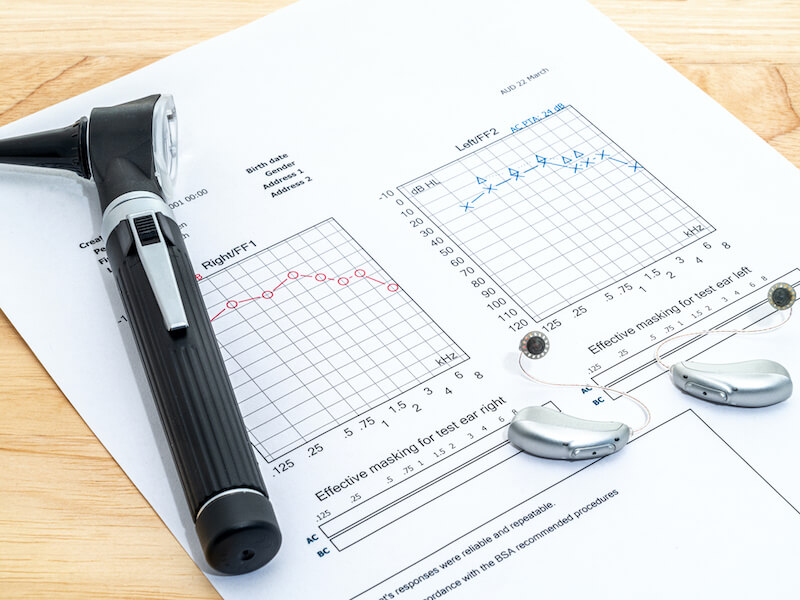Measuring hearing loss is more complex than it might seem at first. If you’re suffering from hearing loss, you can probably hear some things clearly at a lower volume, but not others. You might confuse certain letters like “S” or “B”, but hear other letters just fine at any volume. When you learn how to read your hearing test it becomes clearer why your hearing seems “inconsistent”. It’s because there’s more to hearing than just turning up the volume.
How do I read the results of my audiogram?
An audiogram is a type of hearing test that hearing professionals use to determine how you hear. It won’t look as simple as a scale from one to ten. (Wouldn’t it be great if it did!)
Instead, it’s written on a graph, which is why many find it confusing. But you too can understand a hearing test if you know what you’re looking at.
Reading volume on a hearing test
Along the left side of the chart is the volume in Decibels (dB) from 0 (silent) to around 120 (thunder). The higher the number, the louder the sound must be for you to hear it.
If you can’t hear any sound until it is around 30 dB then you have mild hearing loss which is a loss of volume between 26 and 45 dB. If hearing starts at 45-65 dB then you have moderate hearing loss. Hearing loss is severe if your hearing starts at 66-85 dB. Profound hearing loss means that you can’t hear until the volume reaches 90 dB or more, which is louder than a lawnmower.
Reading frequency on a hearing test
Volume isn’t the only thing you hear. You hear sound at different frequencies, commonly called pitches in music. Frequencies allow you to distinguish between types of sounds, including the letters of the alphabet.
Along the bottom of the chart, you’ll generally see frequencies that a human ear can hear, going from a low frequency of 125 (deeper than a bullfrog) to a high frequency of 8000 (higher than a cricket)
A hearing specialist tests how well you hear frequencies in between and can then plot them on the chart.
So, for example, if you have high-frequency hearing loss, in order for you to hear a high-frequency sound it may have to be at least 60 dB (which is about the volume of a raised, but not yelling, voice). The volume that the sound must reach for you to hear each frequency varies and will be plotted on the chart.
Why measuring both volume and frequency is so important
Now that you know how to read your hearing test, let’s look at what those results might mean for you in the real world. High-frequency hearing loss, which is a very common type of loss would make it harder to hear or understand:
- Women and children who tend to have higher-pitched voices
- “F”, “H”, “S”
- Whispers even if volume hearing is good
- Beeps, dings, and timers
- Birds
- Music
While a person with high-frequency hearing loss has more trouble with high-frequency sounds, some frequencies may seem easier to hear than others. Inside your inner ear you have tiny hair-like nerve cells that move with sounds.
If the cells that pick up a certain frequency become damaged and eventually die, you lose your ability to hear that frequency at lower volumes. If all of the cells that pick up that frequency are damaged, then you completely lose your ability to hear that frequency regardless of volume.
This type of hearing loss can make some interactions with loved ones very frustrating. You may have trouble only hearing specific frequencies, but your family members might assume they have to yell to be heard at all. On top of that, those with this type of hearing impairment find background noise overshadows louder, higher-frequency sounds like your sister speaking to you in a restaurant.
Hearing professionals use the hearing test to personalize hearing solutions
When a hearing specialist understands which frequencies you cannot hear well or at all, they can program a hearing aid to meet each ear’s unique hearing profile. In modern digital hearing aids, if a frequency enters the hearing aid’s microphone, the hearing aid instantly knows whether you can hear that frequency. It can then either make that frequency louder so you can hear it. Or it can change the frequency through frequency compression to another frequency you can hear. In addition, they can improve your ability to process background noise.
This creates a smoother more natural hearing experience for the hearing aid wearer because rather than just making everything louder, it’s meeting your unique hearing needs.
